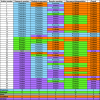Conflation of prediction and causality in the TB literature
- PMID: 40657268
- PMCID: PMC12248412
- DOI: 10.5588/ijtldopen.25.0142
Conflation of prediction and causality in the TB literature
Abstract
Background: Observational data can answer both predictive and etiologic research questions; however, the model-building approach and interpretation of results differ based on the research goal (i.e., prediction versus causal inference). Conflation occurs when aspects of the methodology and/or interpretation that are unique to prediction or etiology are combined or confused, potentially leading to biased results and erroneous conclusions.
Methods: We conducted a rapid review using MEDLINE (2018-2023) of a subset of the observational TB literature: cohort studies among people with drug-resistant TB that considered HIV status an exposure of interest and reported on TB treatment outcomes. For each article, we assessed the research question, statistical approach, presentation of results, and discussion and interpretation of results.
Results: Among the 40 articles included, 32 (80%) had evidence of conflation. The most common specific types of conflation were recommending or proposing interventions to modify exposures in a predictive study and having a causal interpretation of predictors, with both types frequently co-occurring.
Conclusion: Conflation between prediction and etiology was common, highlighting the importance of increasing awareness about it and its potential consequences. We propose simple steps on how TB and lung health researchers can avoid conflation, beginning with clearly defining the research question.
Keywords: data interpretation; drug-resistant; epidemiologic methods; risk factors; tuberculosis.
© 2025 The Authors.
Conflict of interest statement
Conflicts of interest: none declared.
Figures


Similar articles
-
Comparison of Two Modern Survival Prediction Tools, SORG-MLA and METSSS, in Patients With Symptomatic Long-bone Metastases Who Underwent Local Treatment With Surgery Followed by Radiotherapy and With Radiotherapy Alone.Clin Orthop Relat Res. 2024 Dec 1;482(12):2193-2208. doi: 10.1097/CORR.0000000000003185. Epub 2024 Jul 23. Clin Orthop Relat Res. 2024. PMID: 39051924
-
Measures implemented in the school setting to contain the COVID-19 pandemic.Cochrane Database Syst Rev. 2022 Jan 17;1(1):CD015029. doi: 10.1002/14651858.CD015029. Cochrane Database Syst Rev. 2022. Update in: Cochrane Database Syst Rev. 2024 May 2;5:CD015029. doi: 10.1002/14651858.CD015029.pub2. PMID: 35037252 Free PMC article. Updated.
-
Xpert® MTB/RIF assay for pulmonary tuberculosis and rifampicin resistance in adults.Cochrane Database Syst Rev. 2013 Jan 31;(1):CD009593. doi: 10.1002/14651858.CD009593.pub2. Cochrane Database Syst Rev. 2013. Update in: Cochrane Database Syst Rev. 2014 Jan 21;(1):CD009593. doi: 10.1002/14651858.CD009593.pub3. PMID: 23440842 Free PMC article. Updated.
-
Maternal and neonatal outcomes of elective induction of labor.Evid Rep Technol Assess (Full Rep). 2009 Mar;(176):1-257. Evid Rep Technol Assess (Full Rep). 2009. PMID: 19408970 Free PMC article.
-
Undernutrition as a risk factor for tuberculosis disease.Cochrane Database Syst Rev. 2024 Jun 11;6(6):CD015890. doi: 10.1002/14651858.CD015890.pub2. Cochrane Database Syst Rev. 2024. PMID: 38860538 Free PMC article.
References
-
- Hernán MA, Hsu J, Healy B. A Second Chance to Get Causal Inference Right: A Classification of Data Science Tasks. CHANCE 2019;32(1):42-49.
-
- Hernán MA, Robins JM (2020). Causal Inference: What If. Boca Raton: Chapman & Hall/CRC.
LinkOut - more resources
Full Text Sources
